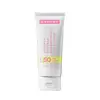What's inside
What's inside
 Key Ingredients
Key Ingredients

 Benefits
Benefits

 Concerns
Concerns

 Ingredients Side-by-side
Ingredients Side-by-side

Water
Skin ConditioningEthylhexyl Methoxycinnamate
UV AbsorberAloe Barbadensis Extract
Skin ConditioningNiacinamide
SmoothingDicaprylyl Carbonate
EmollientMethylene Bis-Benzotriazolyl Tetramethylbutylphenol
UV FilterGlycerin
HumectantDiethylamino Hydroxybenzoyl Hexyl Benzoate
UV FilterCentella Asiatica Extract
CleansingSteareth-21
CleansingDibutyl Adipate
EmollientDimethicone
EmollientChamomilla Recutita Flower Extract
MaskingSodium Hyaluronate
HumectantHydrolyzed Sodium Hyaluronate
Skin ConditioningSodium Acetylated Hyaluronate
HumectantSodium Hyaluronate Crosspolymer
HumectantTocotrienols
Skin ConditioningEthylhexyl Triazone
UV AbsorberGlyceryl Glucoside
HumectantPentylene Glycol
Skin ConditioningPropylene Glycol
HumectantSodium Stearoyl Glutamate
CleansingSodium Polyacrylate
AbsorbentXanthan Gum
EmulsifyingSodium Gluconate
Skin ConditioningDecyl Glucoside
CleansingPhenoxyethanol
PreservativeEthylhexylglycerin
Skin ConditioningWater, Ethylhexyl Methoxycinnamate, Aloe Barbadensis Extract, Niacinamide, Dicaprylyl Carbonate, Methylene Bis-Benzotriazolyl Tetramethylbutylphenol, Glycerin, Diethylamino Hydroxybenzoyl Hexyl Benzoate, Centella Asiatica Extract, Steareth-21, Dibutyl Adipate, Dimethicone, Chamomilla Recutita Flower Extract, Sodium Hyaluronate, Hydrolyzed Sodium Hyaluronate, Sodium Acetylated Hyaluronate, Sodium Hyaluronate Crosspolymer, Tocotrienols, Ethylhexyl Triazone, Glyceryl Glucoside, Pentylene Glycol, Propylene Glycol, Sodium Stearoyl Glutamate, Sodium Polyacrylate, Xanthan Gum, Sodium Gluconate, Decyl Glucoside, Phenoxyethanol, Ethylhexylglycerin
Water
Skin ConditioningEthylhexyl Methoxycinnamate
UV AbsorberC12-15 Alkyl Benzoate
AntimicrobialCaprylic/Capric Triglyceride
MaskingButyl Methoxydibenzoylmethane
UV AbsorberSodium Acrylates Copolymer
Benzophenone-3
UV AbsorberButylene Glycol
HumectantPropanediol
SolventTetrahexyldecyl Ascorbate
AntioxidantTocopheryl Acetate
AntioxidantCitrus Junos Extract
AntioxidantPhoenix Dactylifera Seed Extract
MoisturisingPhospholipids
Skin ConditioningXylitol
HumectantGlucose
HumectantAnhydroxylitol
HumectantLecithin
EmollientEthoxydiglycol
HumectantSodium Gluconate
Skin ConditioningEthylhexylglycerin
Skin ConditioningPhenoxyethanol
PreservativeWater, Ethylhexyl Methoxycinnamate, C12-15 Alkyl Benzoate, Caprylic/Capric Triglyceride, Butyl Methoxydibenzoylmethane, Sodium Acrylates Copolymer, Benzophenone-3, Butylene Glycol, Propanediol, Tetrahexyldecyl Ascorbate, Tocopheryl Acetate, Citrus Junos Extract, Phoenix Dactylifera Seed Extract, Phospholipids, Xylitol, Glucose, Anhydroxylitol, Lecithin, Ethoxydiglycol, Sodium Gluconate, Ethylhexylglycerin, Phenoxyethanol
 Reviews
Reviews

Ingredients Explained
These ingredients are found in both products.
Ingredients higher up in an ingredient list are typically present in a larger amount.
Ethylhexyl Methoxycinnamate is an organic compound that provides UVB protection. It often goes by the more common name of octinoxate. It is created from methoxycinnamic acid and 2-ethylhexanol.
Ethylhexyl Methoxycinnamate absorbs UVB rays with wavelengths between 280-320 nm. UV absorbers protect your skin by using chemical reactions to convert UV rays into heat and energy.
UVB (290-320 nm) rays emit more energy than UVA rays. They are capable of damaging DNA, causing sunburns and are thought to be linked to skin cancer.
The state of Hawaii has banned sunscreens containing octinoxate due to its potential impact on coral reefs. More research is needed to bridge gaps in this research. The European Union allows higher levels of octinoxate in sunscreens than the US and Australia.
Ethylhexyl Methoxycinnamate is oil soluble. It is not stable and may lose efficacy when exposed to sunlight.
Learn more about Ethylhexyl MethoxycinnamateEthylhexylglycerin (we can't pronounce this either) is commonly used as a preservative and skin softener. It is derived from glyceryl.
You might see Ethylhexylglycerin often paired with other preservatives such as phenoxyethanol. Ethylhexylglycerin has been found to increase the effectiveness of these other preservatives.
Phenoxyethanol is a preservative that has germicide, antimicrobial, and aromatic properties. Studies show that phenoxyethanol can prevent microbial growth. By itself, it has a scent that is similar to that of a rose.
It's often used in formulations along with Caprylyl Glycol to preserve the shelf life of products.
This is the synthetic salt of gluconic acid, a form of PHA and mild exfoliant.
It is mainly used to stabilize oil and butter formulations from going bad. Sodium gluconate is a humectant, pH regulator, and chelating agent.
Chelating agents help neutralize unwanted metals from affecting the formulation.
Sodium gluconate is water-soluble.
Learn more about Sodium GluconateWater. It's the most common cosmetic ingredient of all. You'll usually see it at the top of ingredient lists, meaning that it makes up the largest part of the product.
So why is it so popular? Water most often acts as a solvent - this means that it helps dissolve other ingredients into the formulation.
You'll also recognize water as that liquid we all need to stay alive. If you see this, drink a glass of water. Stay hydrated!
Learn more about Water